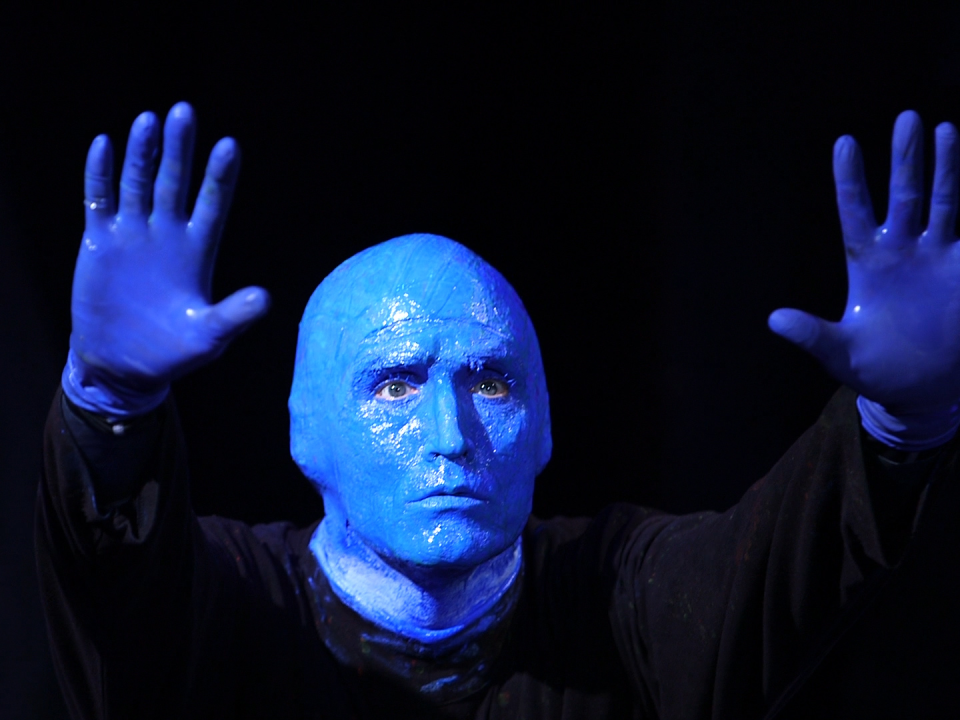What it takes to be a Blue Man

Blue Man Group began performing in Manhattan's Astor Place Theatre in 1991. The original three, Chris Wink, Phil Stanton, and Matt Goldman, put on a variety show featuring music on PVC instruments, art, and food stunts. Twenty-eight years later, the Blue Men are still munching Cap'n Crunch downtown. Following is a transcript of the video.
Randall Jaynes: What is a Blue Man? And the closest answer you can get is it is the other. It is the outsider. It's part, you know, what is it? Childhood. Part imagination. Part fear. Part animal. Blue Man Group is an exploration. It's an investigation into something. You're seeking out that which is disconnected, and trying to reconnect it in a way that is playful and entertaining, and also unexpected, and can be deep and mysterious actually.
Pete Simpson: Believe it or not, it did not start with a Blue Man that didn't speak. It was with a bunch of people. It was with a central three. Chris Wink, Matt Goldman, and Phil Stanton, and their friends.
Steven Wendt: There's a lot of stories about why the Blue Men are blue. One of the creators, I think Chris Wink was visited, like you know, had a vision of a blue man when he was a kid.
Jaynes: It feels still very tied to its sort of avant garde, punk rock, guerrilla theater, humble beginnings. That is very much an aesthetic, community-wide, performance-wide that we hold near and dear. So it doesn't feel in that way it's changed that much. We are auditioning all the time. Nonstop, 24 seven. It averages about one out of every 1,200 people. That's the numbers.
Simpson: Oh, I had to go through a bunch of those auditions. It felt like, like hazing And then you start doing more intensive drumming where you bring in parts of the show, where you're learning show music which involves acting too. So it was about three weeks for me, and then it got certainly more systematized and structured by the time you--
Wendt: It's crazy to hear that.
Bhurin Sead: It's incredible how much the bald cap, and the makeup, and the costume actually transforms you, and changes you when you see yourself in the mirror. It's like, whoa, yeah, I am a Blue Man.
The physical transformation of getting to be a Blue Man takes about half an hour. And that involves laying down a bald cap, having our wardrobe assist us putting it on, putting the grease paint on, putting the costume on. And that's all pretty straightforward, but I feel like the real transformation, and the real getting ready is developing that relationship between the three guys, with the band, with the crew, with everybody working the show that night. And to sort of create a vibe, create an energy and electricity that can transform itself onto the stage, into the show.
Jaynes: There is a natural curiosity and kind of a brightness of spirit that I think one has to either inherently have, or tap into. Important distinction, I don't think people have to walk through the door with this like, you know, I'm a Blue Man, kind of crazy-eyed zing, but you do have to tap into something that is akin to what we all had when we were kids.
There's tons of music, on all sorts of weird instruments. They're not standard. You can't just be a piano player and be like, oh you got it! Or a drummer. We had people who come in and were great drummers who have a hard time with certain elements.
Ben Flint: The PVC instrument is the iconic Blue Man instrument. The show in New York is the original set. It's been around for over 25 years.
Andrew Schneider: One of the things that excites me about Blue Man instruments is this whole three as one concept of it takes three of them to play this instrument, and one of my favorite examples is the PVC instrument that is used in all of the shows. It's similar to a piano in its octave set, but you need all three Blue Men to be playing it at one time and that is a recurring theme in a lot of the instruments in the show.
The drum bone is another example. It basically has five notes total, but it takes three of them to play it. I love that.
Sead: In the show, having those moments when you're face to face with an audience member, and you're not speaking and they're not speaking, there is a spark that happens that I feel that happens that you don't really need to say anything. And that's really powerful, and I feel it every night when that happens. It resonates deeply inside me and it's great.
Simpson: The greatest urgency wouldn't be a physical harm to themselves, it would be the possibility of a broken connection. That'd be the worst thing in the Blue Man's book.
See Also:

 Yahoo News
Yahoo News 
